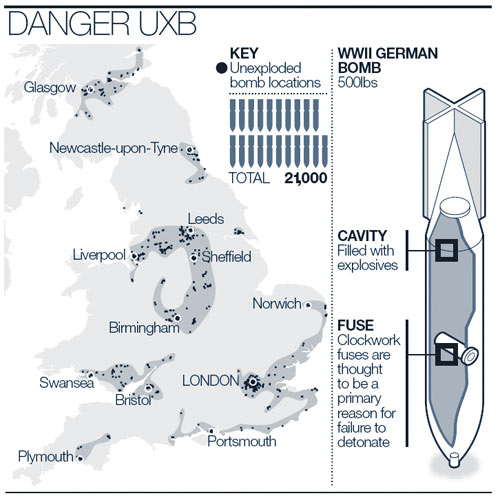
Up to one in ten bombs dropped by the German Luftwaffe failed to detonate leaving a deadly legacy which still lies under the nation’s streets and fields. The new map will be used by builders to tell them the risks from unexploded bombs where they are working. Members of the public will also be able to access the map, which identifies 21,000 locations where there could be unexploded bombs. Experts have studied aerial photographs taken by the RAF after the war and maps created by insurance companies to assess the extent of the bombing damage.
They have been able to pinpoint sites across the UK where unexploded munitions are most likely to be concealed. The cities with the highest number of sites are London, Plymouth, Bristol, Manchester and Birmingham. David Mole, from the Landmark Information Group, which has compiled the charts, said: “Bombs were dropped in sequence and the photographs and maps show where buildings have been demolished. From that we can work out the patterns and where there is most likely to be unexploded ordnance. “In between the areas that were cleared by bombs are pockets that were untouched. Looking at them now, 60 years later, with detailed images of the pattern of destruction around them, you know there is a very good chance there is a bomb in the vicinity.”
Last month, work on the Olympic site, in east London, had to be halted, after the discovery of a 1,000kg unexploded device. A survey has found that the site could contain as many as 200 devices. The online maps are available for all major cities and areas of the countryside where bombings took place.
This cannot be good for real estate values.















So I wonder if they ever just randomly go off…?
Or if a backhoe ever set one off during construction or something like that.
You never really hear that a bomb from ww2 went off. Only that they’ve found them.
Glasgow and the surrounding unexploded bombs around Glasgow are not in England.
it’s central/southern Scotland
I have friends in Glasgow… They are very careful when they dig in the yard… The bombs can still go off!
It doesn’t affect Real estate values in any way.When every property in an area has the same risk the buyers accept this as a precondition of sale.There was a great English series on Masterpiece theater called Danger…UXB.It was about the men sent out to defuse these bombs during the war.Check it out it is worth seeing.
Lebanon has some bombs, too.
In Britain they are as likely to unearth a plague pit (mass grave) or a Roman treasure trove, as a Nazi bomb. All equally inconvenient.
Consider it further reparations for WWI.
If they had treated Germany like they had after WWII, there would have been no Hitler.
Madmen only thrive in a climate of fear and hate.
Cursor_
I loved Danger UXB. Absolutely excellent.
Being the consummate capitalist pig that I proudly am, I am left wondering if there is a moneymaking opportunity here?
Something like GhostBusters… BombBusters?
When Britain was cleaning up after the end of the war, why didn’t the Army remove the unexploded bombs?
Was it too much trouble? Did everyone figure, “Oh, we’ll let future generations worry about these little ol’ things!”?
Or did they figure, “Oh, I’m too tired. Let someone else do it. It’s time for a pint!”?
Who on earth would knowingly and/or willingly just BURY an unexploded bomb??
To ovenmaster. If you don’t know it’s there why would you even look? If it isn’t causing a problem why would you look? Messing with these things is a good way to find out if there is life after death. Unless you have to deal with them don’t. Time is slowly deactivating them.
Some off these things are deep and some aren’t. They are all over Europe including places nobody ever meant to bomb. They show up just about everywhere.
Last and not least if you want a job deactivating these things there are job openings. There are plenty of bombs/mines/old shells/ and such waiting for you to go and make them safe.
You have fun now.
Now I know why I come to DU: education.
No one… and I mean no one… ever bothered to take the time to explain precisely HOW or WHY these bombs show up nearly 70 years later while excavating for new projects. Anyone I ever asked just said “Duhhhh… I dunno!”
Well, except for the wack jobs that held onto a souvenir grenade or three, that is…
Thanks!
They came up with 21000 as the number of possible unexploded bombs merely based on damage assessments during/after the war. 😛 They somehow manage to avoid mentioning that even IF there actually was a bomb at each site to begin with, many of them would have still been found and cleared shortly after, or in the rebuilding after the war. I’m not saying there aren’t a lot left. Just nowhere near the inflated number of “possible” bomb locations.
Like someone else mentioned, the ones left are mostly ones that buried themselves on impact, and were just missed in the subsequent cleanup.
With the number of unexploded bomb reports that circulate, it’s a wonder the number of exploded bomb reports is so low. I don’t recall any in the recent past.
It would be nice if there were official statistics detailing how many unexploded ww2 devices were discovered weekly/monthly/yearly.